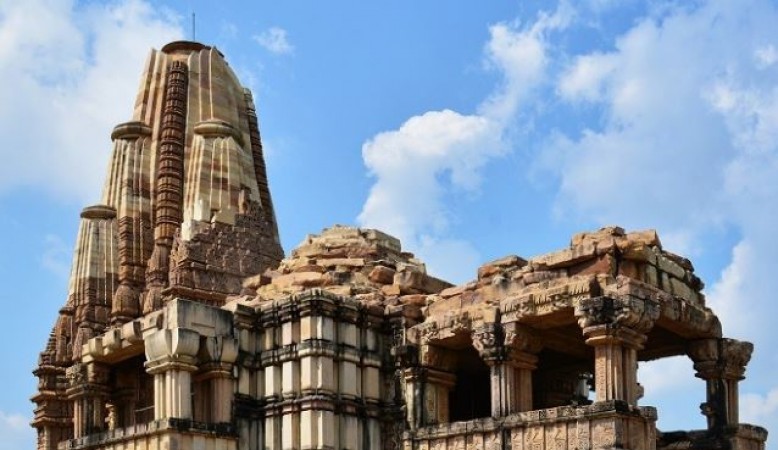
Duladeo Temple is Hindu temple in Khajuraho, Madhya Pradesh they are among the most remarkable and iconic examples of ancient Indian architecture. These temples, dating back to the 10th and 11th centuries, are part of the larger Khajuraho Group of Monuments, a UNESCO World Heritage Site. Renowned for their intricate and explicit depictions of human emotions and various aspects of life, the Khajuraho temples attract visitors from around the world. The Duladeo Temples, in particular, stand out for their unique design, detailed carvings, and spiritual significance.
The Khajuraho Group of Monuments, located in the Chhatarpur district of Madhya Pradesh, India, was constructed during the Chandela dynasty's rule. This dynasty, which reigned between the 9th and 13th centuries, was known for its patronage of art, culture, and religion. The construction of the Khajuraho temples began around 950 AD and continued for over two centuries. These temples were built as places of worship for followers of Hinduism and Jainism.
Also Read: The Mythological Stories and Symbolism Behind Greek Temples
Among the many temples in the Khajuraho complex, the Duladeo Temples are among the last to be constructed. They are believed to have been built around the 11th century during the reign of the Chandela king Yasovarman. The name "Duladeo" is derived from two Sanskrit words: "Dula," meaning "swing," and "Deo," meaning "God." This name is likely related to a swing festival that was once held here during the festival of Holi.
The Duladeo Temples showcase the exquisite architectural style of the Chandela dynasty. The temples follow the Nagara-style architecture typical of northern India during that period. The Nagara style is characterized by its distinct tower-like spires, known as shikharas, which rise gracefully above the temple structures. These spires are adorned with intricate carvings, depicting various deities, celestial beings, and mythical creatures.
Also Read: Hindu Temples and Their Architectural Styles Across India
The temples are constructed using locally available sandstone, which lends them a warm, reddish-brown hue. The intricate carvings on the outer walls of the temples depict a wide range of subjects, including gods, goddesses, celestial nymphs (apsaras), musicians, dancers, and erotic scenes. These sculptures are a testament to the profound understanding and appreciation of human emotions and desires during that era.
The Duladeo Temples consist of a sanctum sanctorum (garbhagriha) where the main deity was placed and an antechamber (antarala) leading to the inner sanctum. The mandapa or main hall serves as a gathering space for devotees during religious ceremonies. The temple's entrance is usually adorned with a grand doorway (torana) featuring intricate carvings.
The temples at Khajuraho, including the Duladeo Temples, were dedicated to various deities of Hinduism and Jainism. Although the exact purpose of each temple may not be known, the presence of various deities and religious motifs indicates that they served as places of worship and spiritual reflection.
Also Read: Lepakshi Veerabhadra Temple: A Glorious Chronicle of Divine Grandeur
In Hinduism, the Duladeo Temples are believed to have been dedicated to Lord Shiva, the destroyer and transformer among the holy trinity of deities (Brahma, Vishnu, and Shiva). The intricate carvings on the walls depict scenes from the Hindu epics, such as the Ramayana and Mahabharata, along with celestial beings and celestial nymphs. These depictions are not just artistic expressions but also convey important moral and philosophical lessons to the visitors.
The Duladeo Temples, along with the other temples at Khajuraho, have been designated as a UNESCO World Heritage Site, recognizing their cultural and historical significance. The Indian government, along with various heritage organizations, has taken significant steps to preserve and protect these ancient temples.
Also Read: Lakshmi Narasimha Temples: A Journey Through History and Rituals
The conservation efforts involve a delicate balance between maintaining the integrity of the structures, preventing further deterioration, and allowing tourists to experience and appreciate their beauty. Regular maintenance, structural reinforcement, and controlled tourism are among the measures taken to safeguard the temples for future generations.
The Duladeo Temples of Khajuraho are more than just architectural marvels; they are living testimonies to India's rich cultural and spiritual heritage. Their intricate carvings, spiritual significance, and historical relevance continue to mesmerize and educate visitors from all corners of the globe. As we delve into the depths of history through the Duladeo Temples, we are reminded of the artistic prowess and cultural glory of ancient India, forever preserved in the sandstone walls of Khajuraho.
Sri Padmanabhaswamy Temple, Kerala: A Historic Abode of Spiritual Grandeur
Hampi: Unveiling the Ancient Marvels and Rich History of the Vijayanagara Empire